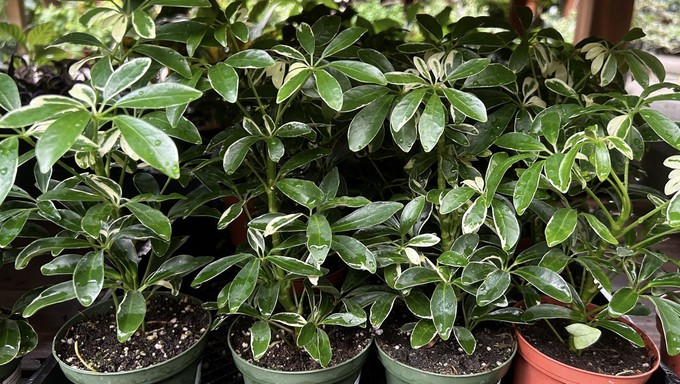
Find out how to transform houseplants into living art at Green Acres in Elk Grove

These dwarf umbrella trees, aka scheffleras, are of the plants that can become bonsai during a workshop Saturday at the Elk Grove Green Acres store. Kathy Morrison
Learn the basic techniques of bonsai during a beginner’s class at Green Acres Nursery & Supply’s Elk Grove store on Saturday, Nov. 9.
Set for 10 a.m. Saturday, “Bonsai 101” will introduce the concepts and skills of this age-old gardening skill. Through thoughtful pruning and root constriction, plants that would grow several feet tall can be artfully kept small and tidy for years, even decades – while displaying their mature form in miniature.
For this class, participants can choose from three different indoor plants – Ming aralia (aka Polyscias fruticosa), Ficus benjamina (weeping fig) or Schefflera (umbrella tree). The workshop includes a 6-inch specimen plant plus potting material, 10-inch bonsai pot, soil, moss, decorative rock and a must-have tool, curved razor snips.
“Our experienced garden gurus will lead you through the process of potting and pruning an indoor bonsai plant,” says Green Acres. “Whether you come as a novice or expert, you’ll leave with the tools and knowledge to tend and shape your bonsai into a beautiful piece of art as it ages.”
Course fee is $55 and the workshop is limited to 20 participants. Sign up here:
https://idiggreenacres.com/products/create-class-elk-grove
Green Acres’ Elk Grove store is located at 9220 E. Stockton Blvd., Elk Grove.
For directions and more details: https://idiggreenacres.com/
Comments
0 comments have been posted.Sacramento Digs Gardening to your inbox.
Food in My Back Yard Series
May 6: Maintain soil moisture with mulch for garden success
April 29: What's (already) wrong with my tomato plants?
April 22: Should you stock up on fertilizer? (Yes!)
April 15: Grow culinary herbs in containers
April 8: When to plant summer vegetables
April 1: Don't be fooled by these garden myths
March 25: Fertilizer tips: How to 'feed' your vegetables for healthy growth
March 18: Time to give vegetable seedlings some more space
March 11: Ways to win the fight against weeds
March 4: Potatoes from the garden
Feb. 25: Plant a fruit tree now -- for later
Feb. 18: How to squeeze more food into less space
Feb. 11: When to plant? Consider staggering your transplants
Feb. 4: Starting in seed starting
Sites We Like
Garden Checklist for week of May 11
Make the most of the lower temperatures early in the week. We’ll be back in the 80s by Thursday.
* Plant, plant, plant! It’s prime planting season in the Sacramento area. Time to set out those tomato transplants along with peppers and eggplants. Pinch off any flowers on new transplants to make them concentrate on establishing roots instead of setting premature fruit.
* Direct-seed melons, cucumbers, summer squash, corn, radishes, pumpkins and annual herbs such as basil.
* Harvest cabbage, lettuce, peas and green onions.
* In the flower garden, direct-seed sunflowers, cosmos, salvia, zinnias, marigolds, celosia and asters. (You also can transplant seedlings for many of the same flowers.)
* Plant dahlia tubers.
* Transplant petunias, marigolds and perennial flowers such as astilbe, columbine, coneflowers, coreopsis, dahlias, rudbeckia and verbena.
* Keep an eye out for slugs, snails, earwigs and aphids that want to dine on tender new growth.
* Feed summer bloomers with a balanced fertilizer.
* For continued bloom, cut off spent flowers on roses as well as other flowering plants.
* Add mulch to the garden to maintain moisture. Mulch also cuts down on weeds. But don’t let it mound around the stems or trunks of trees or shrubs. Leave about a 6-inch-to-1-foot circle to avoid crown rot or other problems.
* Remember to weed! Pull those nasties before they set seed.
* Water early in the day and keep seedlings evenly moist.